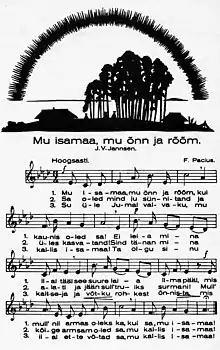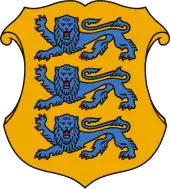Mu isamaa, mu õnn ja rõõm
"Mu isamaa, mu õnn ja rõõm" ('My Fatherland, My Happiness and Joy'; IPA: [mu ˈisɑmɑː mu ˈɤnʲː jɑ ˈrɤːm]) is the national anthem of Estonia. It was adopted as the national anthem ((riigi)hümn) in 1920.
| English: "My Fatherland, My Happiness and Joy" | |
|---|---|
 | |
National anthem of | |
| Lyrics | Johann Voldemar Jannsen, 1869 |
| Music | Fredrik (Friedrich) Pacius, 1848 |
| Adopted | 1920 |
| Readopted | May 1990 |
| Relinquished | June 1940 |
| Preceded by | Anthem of the Estonian Soviet Socialist Republic |
| Audio sample | |
"Mu isamaa, mu õnn ja rõõm" (instrumental, one verse)
| |
The lyrics were written by Johann Voldemar Jannsen and are set to a melody composed in 1848 by Fredrik (Friedrich) Pacius which is also that of the national anthem of Finland: "Maamme" (Swedish: "Vårt Land", which was the unofficial anthem of The Grand Duchy of Finland).[1] The only difference between the two anthems is the key signature they are in. It is also considered to be an ethnic anthem for Livonian people with text "Min izāmō, min sindimō" (English: "My Fatherland, my native land").
History
The song was first presented to the public as a choral work in the Grand Song Festival of Estonia in 1869 and quickly became a symbol of the Estonian National Awakening.
"Mu isamaa, mu õnn ja rõõm" was officially adopted as the national anthem of Estonia in 1920, after the Estonian War of Independence. In contrast, Finland never passed an equivalent legislation for "Maamme", thus it is considered to be the de facto Finnish national anthem.
In 1944, the Soviet Union occupied Estonia and "Mu isamaa, mu õnn ja rõõm" ended up being banned by the Soviet regime. The Soviet Estonia had its own regional anthem. Yet the people of Estonia could often hear their former national anthem as Finland's state broadcaster Yleisradio, whose radio and television broadcasts were received in northern Estonia, played an instrumental version of the Finnish national anthem, identical to this song (except for an additional repetition of the last verse in the Finnish version), at the conclusion of its broadcast every night.
Lyrics
Estonian lyrics
The official lyrics are in Estonian.
| Estonian[2][3] | Broad IPA transcription | |||
|---|---|---|---|---|
| First verse | ||||
Mu isamaa, mu õnn ja rõõm, |
/mu isɑmɑː mu ɤnʲː jɑ rɤːm/ | |||
| Second verse | ||||
Sa oled mind ju sünnitand |
/sɑ oled mind ju synːitɑnd/ | |||
| Third verse | ||||
Su üle Jumal valvaku |
/su yle jumɑl ʋɑlʋɑku/ | |||
Notes
References
- "Estonia - Mu isamaa, mu õnn ja rõõm". NationalAnthems.me. Retrieved 2011-11-21.
- "Riiklikud sümbolid". 13 April 2009. Archived from the original on 13 April 2009.
- "The President of the Republic of Estonia: National Symbols". 14 January 2006. Archived from the original on 14 January 2006.
External links
- The Estonian national anthem - web page of the State Chancellery, an audio stream. The anthem is played by The Defence Forces Orchestra, vocals by the National Male Choir.
- Streaming audio, lyrics and details of the Estonian anthem.

